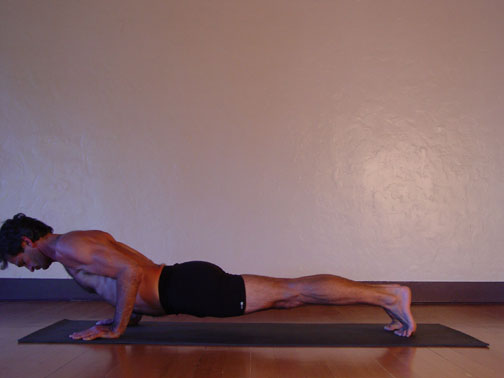Chataranga Dandasana: An Endangered Species
Flowing with Chataranga
Chataranga Dandasana (Four-Limbed Staff Pose) is an endangered species, one increasingly lost in the rushed transition from Plank Pose (Phalakasana) to Upward Facing Dog Pose (Urdhva Mukha Svanasana). The result is not only loss of insight arising in the asana itself, but also the effects on the shoulders, neck and low back when flowing into Up Dog. Let’s explore this.
When flowing among asanas in a vinyasa-type yoga class, the asanas ideally make an actual appearance as asanas. This means being in the asana for a moment – specifically, in the natural pauses in breathing, when the lungs are full or empty. When the breath moves, we move; when it pauses, we pause, and it is there that we experience the asana’s full expression.
To best experience a sustainable Chataranga practice, start with steady breathing, making that more interesting and important than the asana. (As with the entire practice, try to sustain a steady flow in your breathing, with the inhalations and exhalations set to between three and five counts – and punctuated by those natural pauses.)
In most flow-style classes, Chataranga is given as the asana between Plank (Phalakasana) and Up Dog.
Unfortunately, it is often taught and depicted in pictures and videos in a terrbly mis-informed way, with the shoulders coing close to the fingertips. When the shoulder goes lower than the elbow, tremendously greater pressure is placed on the front of the joint capsule and related supportive musculature (especially the anterior deltoid tendon). The physics of this position is injurious enough, let alone the pressure that occurs when initially pressing the hands to lift up into Urdhva Mukha Svanasana (Upward Facing Dog Pose). So it's altogehter disturbing that it;s tught in just this way, especially in Ashtanga Vinyasa and most Vinyasa Flow classes.
Here I will describe the basic elements of healthy transitions from Plank to Chataranga to Up Dog:
Starting in Plank Pose
- Align your shoulders over your wrists and your heels above the balls of your feet.
- Try to create a straight line from your shoulders to your hips to your ankles.
- Press down firmly across the entire span of your hands (especially the knuckles of the index fingers) while rooting your shoulder blades down your back.
- Press back through your heels while drawing your sternum forward, firming your thighs while lightly engaging your belly to maintain stability through the center of your body.
Transition to Chataranga
- Maintaining all the actions of plank (active hands, legs, belly lightly engaged, shoulder blades down back, sternum drawing forward), on an exhalation slowly start to bend your elbows while keeping them aligned directly behind your shoulders. Lower to where your shoulders are level with your elbows while keeping your shoulder blades drawing down against your back ribs. Hold Chataranga just for the length of the natural pause in the breath when empty of breath.
- Keep your legs active by pressing back through your heels.
- Maintain pressure down through the knuckles of the index fingers.
- Keep your shoulders level with your elbows and rooted down against your back ribs, thereby stabilizing your shoulders while creating more space and ease around your neck and across your chest.
- Keep your head level with your shoulders throughout this transition (noting the tendency to lower the head).
Transition to Up Dog
- On an inhalation, slowly press your arms straight while extending your feet straight back to create the basic form of the posture. Try to keep your shoulders from dipping towards the floor when starting this transition.
- As you begin to press your arms straight, create a feeling of spiraling your palms outward (without moving them) to help expand across your chest.
- Slowly draw the curve up your spine, adding your neck to the backbend only at the last moment (if at all).
- Align your shoulders directly over your wrists. This alignment is primarily determined by how you transition your feet. If you roll over your toes, your hips will shift forward and you’re more likely to hyperextend your wrists. If you extend your feet back, you’re more likely to end up with your wrists ahead of your shoulders.
- In the brief moment that you are in Up Dog (in the natural pause filled with breath), fully commit to rooting your feet, and create a feeling of pulling your pelvis forward while allowing a feeling of your tail bone drawing towards the floor, thereby creating the foundation for the backbend and reducing pressure in the low back.
- As you root down through your hands, pull your shoulders back, lift your sternum and create a feeling of pressing your mid-spine forward into your heart.
- Again, add your neck to the backbend last, or consider keeping your head level to take it easier on your neck.
The key in all of this is patience and pace. Some teachers’ rapid-fire instructions often cue movements from asana to asana with less than two breath-counts (that’s two seconds), so it’s all moving for too fast, while lack of physical strength makes hovering in Chataranga for even one second very difficult. Being patient in developing strength, and moving more slowly to move more consciously and with greater physical integrity, makes this transition an altogether better experience.
Making the breath more interesting and important that the pace, pose, or practically anything else is the key to keeping Chataranga off the endangered species list.
Keep breathing – as though you life depends on it!
